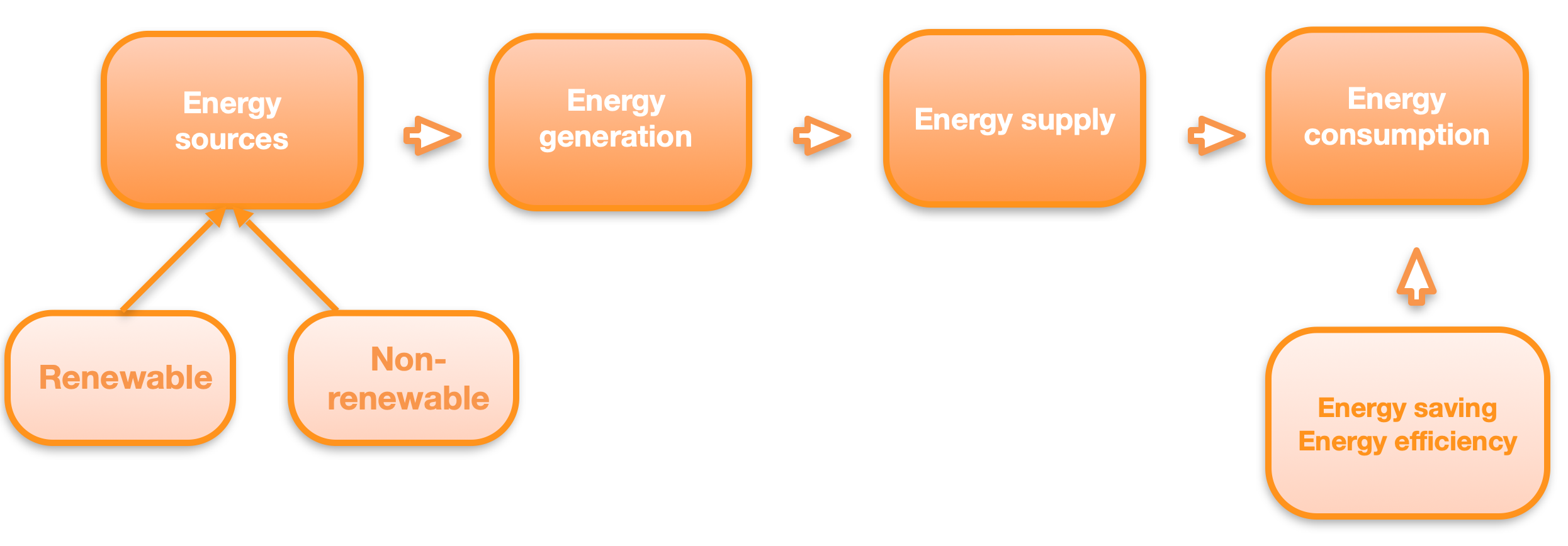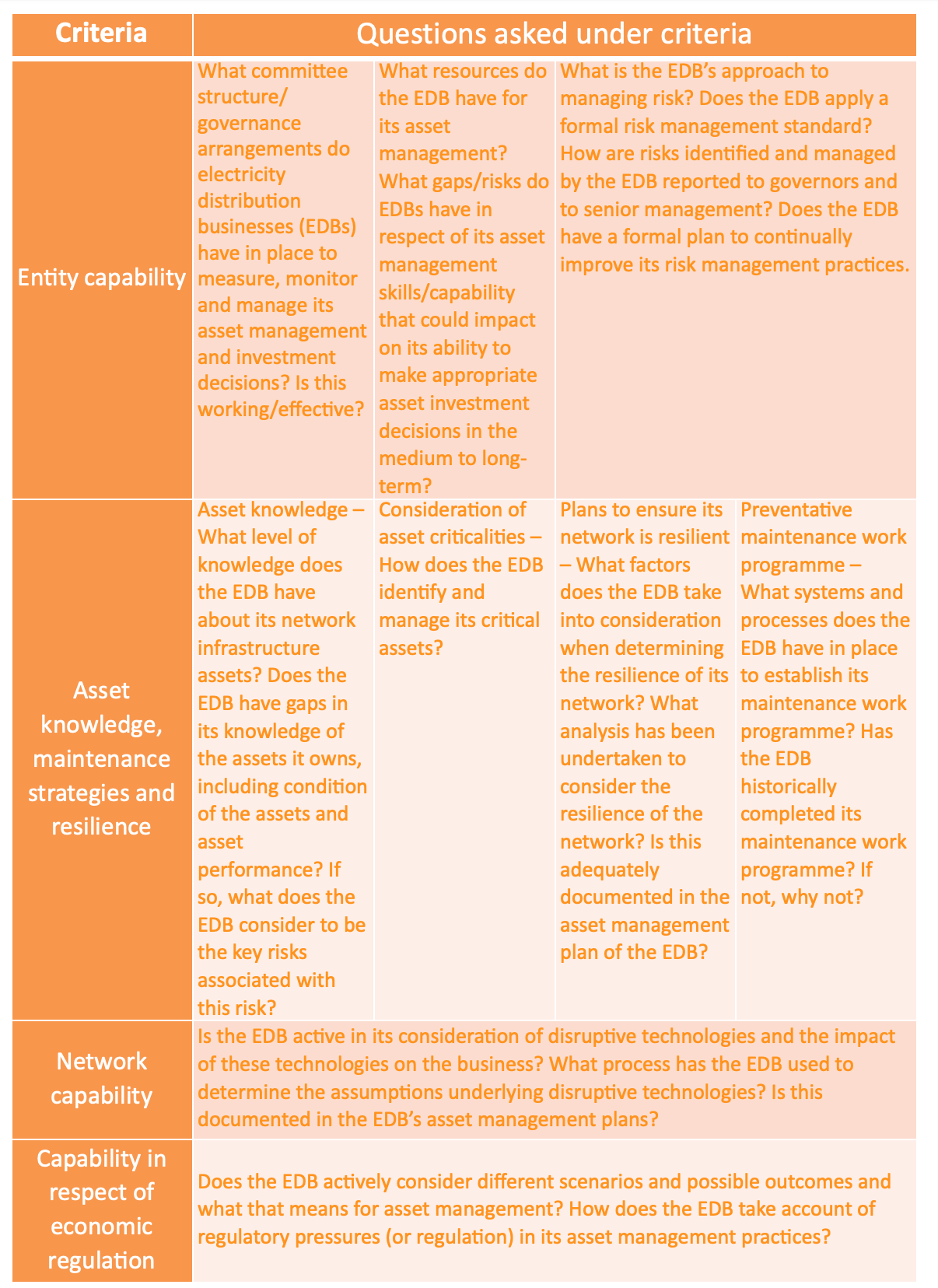MOOC: Auditing environmental impacts of infrastructure
3.4. Sustainability aspects of energy infrastructure
The sustainability of energy can cover a variety of topics from energy security to energy efficiency and renewable energy and even the quality of the energy transmission and/or distribution network.
The main advantage of renewable energy sources over non-renewable resources (namely fossil fuels) is that there is a virtually unlimited supply of renewable resources. Hence, renewable energy sources are considered sustainable. Following the same logic, nuclear energy could be considered sustainable. In fact, nuclear energy is sustainable in the sense that there are unlimited resources of it. Nevertheless, renewable energy contributes to sustainability by also being environmentally friendly. Although, like renewable energy and unlike fossil fuels, nuclear energy plants do not pollute the air, they produce hazardous waste and can pose a threat to the surrounding population. As such, nuclear energy cannot be considered a wholly sustainable energy source, but renewable energy can be considered such.
The other field concerning the sustainability of energy is efficiency. This means not only getting as much energy out of resources as possible in generation plants, but also losing as little energy as possible in transmission and consumption. Thus, energy infrastructure consists not only of power generation plants but also distribution grids, cooling installations, boiler plants for heating and pipelines for delivering heating and/or cooling. Energy efficiency even covers how well the buildings in which the energy is used have been built, i.e. how energy efficient they are. This means that the less energy consumed for heating and cooling the better, but at the same time, a good inner climate must be ensured.
Energy efficiency should not be mixed up with energy conservation, though. The latter encompasses steps by the consumer to use less energy. For example, turning off the lights or heating when not in the house is considered energy conservation. If less energy were to be used because the consumer would replace the lights or heating system with more efficient ones, that would be considered energy efficiency. Put simply, energy conservation means the consumer changes his or her behaviour in order to save energy while energy efficiency means that the behaviour remains the same while the, for example, devices used are more effiecient and energy is saved because of that. The end goal of both of these approaches is energy saving.
The following illustration (source: Auditing Sustainable Energy) depicts the energy chain.

Like anywhere nowadays, IT solutions are becoming increasingly prominent in energy infrastructure and also contribute greatly to the sustainability of the infrastructure. Take smart grids, for example, which follow energy consumption and production. They are not only vital for the growing use of at times volatile renewable sources, but also enable the roll out of new technology, such as energy storage, and empower prosumers – energy users who also produce energy.
According to the European Commission Smart Grids Task Force, a smart grid employs innovative products and services with intelligent monitoring, control, communication and self-healing technology in order to:
- Allow consumers to play a part in the system;
- Provide energy suppliers and customers with greater information;
- Better facilitate the connection and operation of generators of all sizes and technology;
- Accommodate renewable energy peaks in the grid and allow for load management;
- Significantly reduce the environmental impact of the entire electricity supply system;
- Contain the costs of the transition to a low-emission supply by intelligent planning;
- Maintain or even improve the existing high levels of system reliability, quality and security of supply;
- Maintain and improve the existing services efficiently and facilitate the development of new services;
- Allow demand-response programs, services and products; and
- Foster cross-border market integration.
 |
Take a look at this interactive map for more information on smart grid projects around the world. |
 | Reading suggestion!See more on the sustainability of energy in the INTOSAI WGEA material ‘Auditing Sustainable Energy’ (INTOSAI WGEA, 2010). |
The following table shows various questions that can be raised when auditing energy and how these questions relate to different aspects of sustainability.
Sustainability aspects covered by questions |
Questions that can be asked when considering the sustainability of energy infrastructure |
| Economic & social |
Has the state ensured energy security? What are the main sources of energy and how secure are they? Are the transmission and distribution networks reliable and secure? Where is energy (e.g. gas) stored, who owns those facilities? Are the storage facilities secure? What potential political disputes could harm the security of the energy supply and how well have those risks been mitigated? |
| Economic & environmental | What kind of fuel is used for energy production (renewable or fossil)? Does the profit gained from energy production overweigh the harm to the environment and the cost of building and maintaining the production plant? Has the state analysed both the direct and additional costs of energy production when making plans and decisions for the future (e.g. the need for subsidies)? What kind of policy instruments (subsidies, taxes, permits, levies, etc.) exist for energy production? Do these instruments perform the goal they were set out to achieve (e.g. reduction of emissions or increase in energy produced from renewables)? Are these instruments temporary, i.e. aimed at solving a problem and only in force until the problem is solved? |
| Environmental & social | How big are the emissions into the air, water and soil? How much waste is generated? How is the energy price formed (open market or regulators)? |
| Environmental, social & economic | How big are the energy losses from pipelines and grids? Has there been sufficient investment for the renewal of infrastructure? How is the infrastructure maintained? Is the infrastructure ready for a transmission to renewable energy use? |
Audit example:
‘Managing the assets that distribute electricity’ (Controller and Auditor-General, New Zealand, 2017)
The audit examined how electricity distribution businesses were managing, maintaining, and investing in their networks to ensure they could provide services to consumers for the long term. It is important that entities that distribute electricity throughout New Zealand manage their networks well to ensure a safe and reliable supply to their customers, now and in the future.
The main audit question was:
- Are electricity distribution businesses adequately investing in their networks to ensure that they continue to deliver the services required for future generations?
The citeria used in the audit are further explained below:

 | Audit suggestion!12 SAIs – Brazil, Chile, Colombia, Costa Rica, Cuba, Ecuador, El Salvador, Guatemala, Honduras, Mexico, Paraguay and Venezuela – along with the technical support of the Brazil-Germany Cooperation for Sustainable Development, through GIZ (Deutsche Gesellschaft für Internationale Zusammenarbeit GmbH), carried out an analysis on public policies and investments relat-ed to the expansion of renewable energy in the electric power sector. One of the goals of the coordinated audit was identifying good practices and opportunities for improvement in these policies in order to contribute to achieving the commitments of the SDGs and the Paris Agreement. Here, you can access information on the audit in English. You will be able to find documents, such as preparatory benchmarking, planning matrix, findings matrix, and products for disseminating the results (complete report, executive summary, one-pager and infographic), some of which are in English. |

